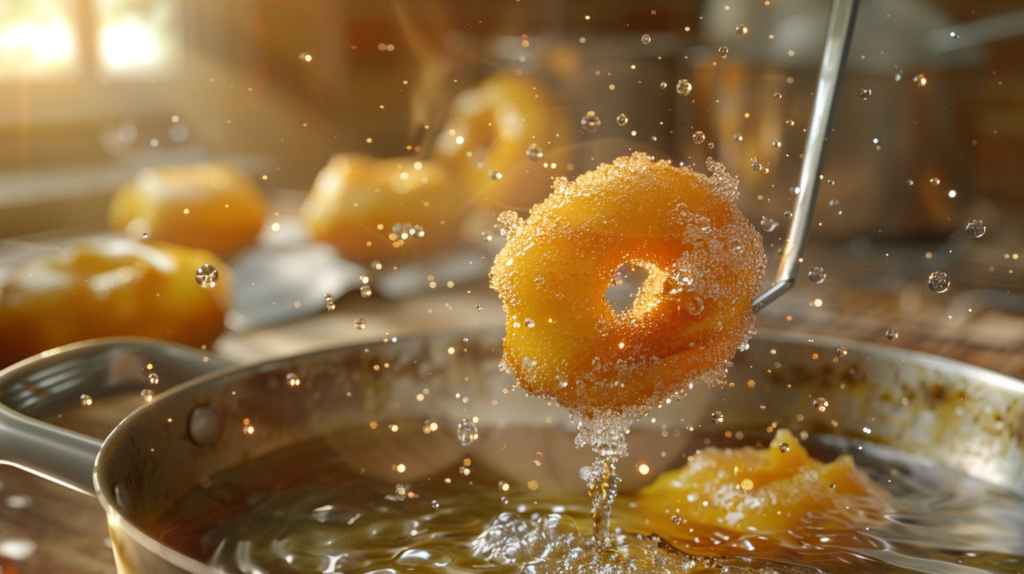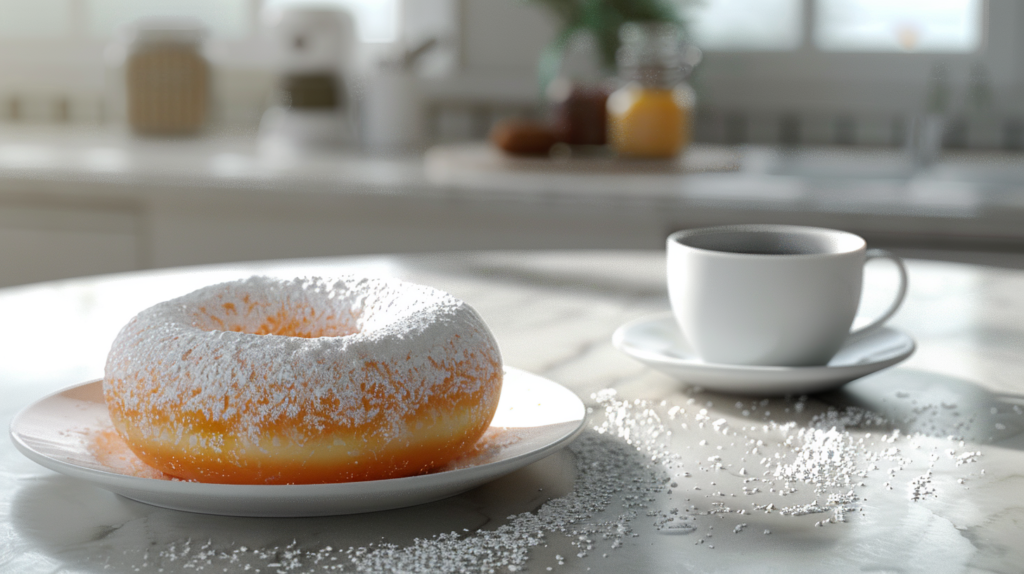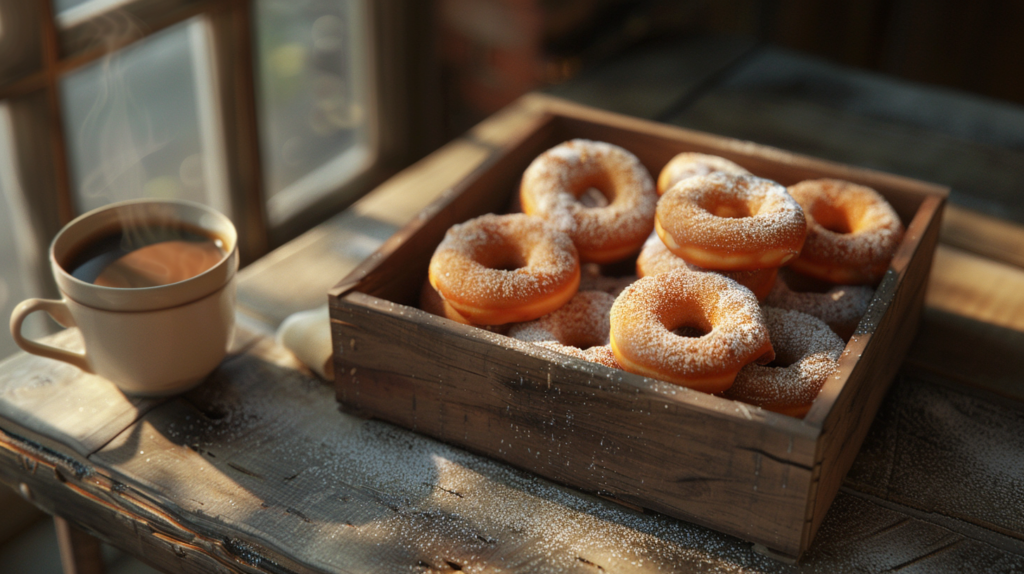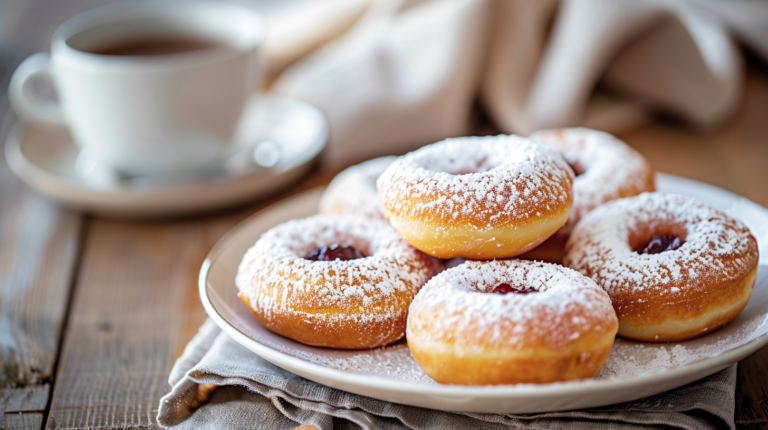Homemade Doughnuts Recipe – Soft, Fluffy & Irresistible
Introduction
Doughnuts have been a beloved treat for centuries, enjoyed in different forms across cultures. Whether glazed, powdered, or filled, their soft, fluffy texture and irresistible sweetness make them a favorite worldwide. In this introduction, we’ll explore the history of doughnuts, why making them at home is better than store-bought, and which countries consume the most doughnuts.
The Origins of Doughnuts
The exact origin of doughnuts is debated, but their history can be traced back to ancient fried dough recipes from various cultures. The Dutch are credited with introducing “olykoeks” (oily cakes) to America in the 17th century, which were round, fried pastries similar to modern doughnuts. However, the issue of raw dough in the center led to the invention of the iconic ring-shaped doughnut, widely attributed to Hanson Gregory, an American sailor, in 1847.
Doughnuts gained massive popularity in the early 20th century, especially with the invention of the automated doughnut-making machine in 1920. They became a staple in bakeries, cafés, and even military rations during World War I, where they were served to soldiers for comfort and energy.
Why Homemade Doughnuts Are Better Than Store-Bought
While store-bought doughnuts are convenient, homemade doughnuts offer superior taste, texture, and quality. Here’s why:
- Fresher Ingredients – No preservatives or artificial flavors.
- Better Texture – Freshly fried doughnuts have a crisp outer layer and a soft, airy inside.
- Customizable Flavors – You control the sweetness, fillings, and toppings.
- Healthier Options – Baked alternatives, reduced sugar, or healthier oil choices.
Top 10 Countries That Love Doughnuts the Most
Doughnuts are enjoyed globally, but some countries have a notable obsession with them. Here are the top 10:
- United States – Home to Krispy Kreme, Dunkin’, and an annual National Doughnut Day.
- Canada – Tim Hortons alone sells millions of doughnuts daily.
- Japan – Known for its creative flavors, like matcha and mochi doughnuts.
- United Kingdom – A popular bakery treat, often filled with jam or custard.
- Australia – Doughnuts are a staple at coffee shops and food markets.
- Germany – Berliner doughnuts are a traditional favorite.
- France – Beignets and filled doughnuts are loved across the country.
- Poland – Famous for Pączki, deep-fried doughnuts filled with jam.
- Netherlands – Oliebollen, a traditional Dutch fried pastry, is a national treasure.
- South Korea – Trendy cafés serve doughnuts with unique flavors like sweet potato and black sesame.
Homemade doughnuts allow you to enjoy a fresh, warm batch of this beloved pastry without relying on store-bought versions. Let’s dive into the ingredients and tools you’ll need!
What You’ll Need
Making homemade doughnuts requires the right tools and ingredients to achieve that soft, fluffy texture and perfect golden-brown finish. Here’s everything you need to get started.

Essential Tools
1. Mixing Bowls
You’ll need at least two mixing bowls—one for preparing the dough and another for allowing it to rise properly.
2. Rolling Pin
A rolling pin helps roll out the dough evenly to the perfect ½-inch thickness before cutting the doughnuts.
3. Doughnut Cutter or Round Cutter
A specialized doughnut cutter (or two round cutters of different sizes) ensures uniform doughnuts. You can also use a drinking glass and a bottle cap for the center hole.
4. Deep Fryer or Heavy-Bottomed Pot
For crispy, evenly fried doughnuts, use a deep fryer or a sturdy, heavy-bottomed pot to maintain oil temperature.
5. Cooling Rack
A cooling rack prevents sogginess by allowing excess oil to drain properly, keeping doughnuts light and crisp.
Doughnut Ingredients
1. All-Purpose Flour (3 ½ cups)
Flour forms the dough’s structure, giving doughnuts their soft yet chewy texture.
2. Active Dry Yeast (1 packet – 2 ¼ tsp)
Yeast helps the dough rise, making it light and airy. Ensure it’s fresh for the best results.
3. Warm Milk (1 cup)
Warm milk activates the yeast, enhances flavor, and enriches the dough. Use dairy or plant-based alternatives if needed.
4. Granulated Sugar (¼ cup)
Sugar adds sweetness and helps activate the yeast. It also contributes to a beautifully golden-brown crust.
5. Egg (1 large)
Eggs enhance the dough’s elasticity, improving structure and texture. For a vegan version, use a flax egg (1 tbsp flaxseed meal + 3 tbsp water).
6. Unsalted Butter (¼ cup, melted)
Butter gives the dough richness and softness. Substitute with coconut oil or vegan butter if needed.
7. Salt (½ tsp)
A pinch of salt balances the sweetness and enhances the overall flavor.
8. Vanilla Extract (1 tsp)
Vanilla adds depth and enhances the doughnut’s aroma and taste.
9. Oil for Frying
Use neutral, high-smoke-point oils like vegetable, canola, or peanut oil for best results.
Optional Toppings
Once fried, your doughnuts can be customized with delicious toppings:
- Powdered Sugar – Lightly dust for a classic finish.
- Chocolate Glaze – A rich, glossy chocolate coating.
- Cinnamon Sugar – A warm, fragrant mix of sugar and cinnamon.
With all the tools and ingredients ready, let’s move on to making the perfect doughnuts!
Step-by-Step Instructions
Making homemade doughnuts requires patience, but the result is soft, fluffy, and delicious pastries. Follow these steps for the perfect doughnuts every time.

Step 1: Prepare the Dough
Activate the Yeast
- In a small bowl, combine 1 cup warm milk, ¼ cup granulated sugar, and 2 ¼ tsp active dry yeast.
- Stir gently and let it sit for 5-10 minutes until it becomes foamy. This step ensures the yeast is active and will help the dough rise properly.
Mix the Wet and Dry Ingredients
- In a large mixing bowl, add the activated yeast mixture.
- Whisk in 1 egg, ¼ cup melted butter, ½ tsp salt, and 1 tsp vanilla extract.
- Gradually add 3 ½ cups all-purpose flour, stirring continuously until the dough starts forming.
Knead the Dough
- Transfer the dough to a floured surface and knead for 8-10 minutes until it becomes smooth and elastic.
- If the dough is sticky, add a little flour (1 tbsp at a time) until it reaches the right consistency.
Step 2: Let the Dough Rise
First Rise
- Place the dough in a greased bowl, cover it with a damp cloth, and let it rise in a warm place for 1-2 hours or until it doubles in size.
- The dough is ready when you press it lightly and the indentation remains.
Step 3: Shape the Doughnuts
Roll Out the Dough
- Once risen, transfer the dough onto a lightly floured surface.
- Roll it out to about ½ inch thickness using a rolling pin.
Cut Out Doughnut Shapes
- Use a doughnut cutter (or a round cutter and a smaller cutter for the hole) to cut out doughnut shapes.
- Place them on a baking sheet lined with parchment paper, ensuring they are spaced apart.
Second Rise
- Cover the cut-out doughnuts with a cloth and let them rest for 30 minutes. This helps them become even fluffier when fried.
Step 4: Fry the Doughnuts
Heat the Oil
- Pour enough oil into a deep fryer or heavy-bottomed pot to reach about 2-3 inches deep.
- Heat to 350°F (175°C)—use a thermometer to maintain the temperature.
Frying Process
- Carefully add the doughnuts one at a time, frying for about 1 minute per side until golden brown.
- Use a slotted spoon to remove them and transfer them to a cooling rack lined with paper towels to drain excess oil.
Step 5: Add Toppings
- While still warm, coat your doughnuts with your favorite toppings:
- Dust with powdered sugar for a classic touch.
- Dip in chocolate glaze for a rich, sweet finish.
- Roll in cinnamon sugar for a fragrant, crispy coating.
Now, your homemade doughnuts are ready to enjoy!
Nutrition Score (Per Doughnut)
Understanding the nutritional breakdown of homemade doughnuts helps you enjoy them while maintaining a balanced diet. Here’s what you get in one doughnut:

Caloric Breakdown
Calories: 220 per doughnut
Each doughnut provides a moderate energy boost, making it a perfect treat for breakfast or dessert.
Macronutrient Profile
- Carbohydrates: 30g – Primarily from flour and sugar, providing quick energy.
- Protein: 4g – From eggs and flour, contributing to muscle repair and satiety.
- Fat: 10g – Mainly from butter and frying oil, giving the doughnuts a rich texture.
- Sugar: 8g – Moderate sweetness, adjustable based on toppings.
Micronutrient Benefits
- Iron & B Vitamins – Found in all-purpose flour, aiding energy production.
- Calcium – From milk, supporting bone health.
- Healthy Fats – If fried in high-quality oil, doughnuts retain some heart-friendly unsaturated fats.
While doughnuts are a treat food, making them at home allows you to control ingredients, reducing processed additives and excess sugar.
Serving & Storage
To enjoy homemade doughnuts at their best, follow these serving and storage tips to maintain their freshness and flavor.
Serving Suggestions
Best Ways to Enjoy Homemade Doughnuts
- Fresh & Warm – Doughnuts taste best when eaten fresh, just minutes after frying.
- With Coffee or Tea – The light sweetness pairs perfectly with a cup of coffee, tea, or hot chocolate.
- As a Dessert – Serve with ice cream, whipped cream, or caramel drizzle for an indulgent treat.
- Breakfast Treat – Pair with fresh fruit for a balanced morning snack.
How to Store Doughnuts Properly
Short-Term Storage (Up to 2 Days)
- Place doughnuts in an airtight container at room temperature.
- Store in a cool, dry place away from moisture.
- If glazed, separate layers with parchment paper to prevent sticking.
Long-Term Storage (Freezing Doughnuts)
For longer storage, freeze doughnuts before frying:
- After cutting the doughnuts, place them on a baking sheet lined with parchment paper.
- Freeze for 1 hour, then transfer to a freezer-safe bag.
- When ready to fry, let them thaw for 1-2 hours before cooking.
Alternatively, fried doughnuts can also be frozen:
- Let them cool completely.
- Place in an airtight container and freeze for up to 2 months.
- Reheat in the oven at 350°F (175°C) for 5-7 minutes to restore crispness.
By following these tips, you can enjoy fresh, homemade doughnuts whenever you crave them!
Variations & Customizations
One of the best things about homemade doughnuts is that they can be easily customized to suit different preferences and dietary needs. Here are some fun variations to try!

Healthier & Dietary Variations
1. Baked Doughnuts (Lower Fat Option)
- Instead of frying, bake the doughnuts at 375°F (190°C) for 12-15 minutes until golden brown.
- The texture will be slightly different—more like a cake doughnut—but still delicious!
2. Glazed Doughnuts (Classic & Chocolate)
- Simple Sugar Glaze: Mix 1 cup powdered sugar, 2 tbsp milk, and ½ tsp vanilla extract until smooth. Dip warm doughnuts in the glaze and let set.
- Chocolate Glaze: Melt ½ cup dark chocolate chips with 2 tbsp butter and 2 tbsp milk for a glossy chocolate coating.
3. Vegan Doughnuts (Dairy & Egg-Free)
- Use almond milk or oat milk instead of dairy milk.
- Replace the egg with a flax egg (1 tbsp flaxseed meal + 3 tbsp water, let sit for 5 minutes).
- Use coconut oil or vegan butter instead of regular butter.
Flavor & Texture Customizations
4. Filled Doughnuts (Custard, Jam, or Nutella)
- After frying, inject jam, custard, or Nutella using a piping bag for a soft, gooey center.
- Dust with powdered sugar for an extra touch.
5. Cinnamon Sugar Doughnuts (Warm & Fragrant)
- While still warm, roll doughnuts in a mix of ½ cup granulated sugar + 1 tsp cinnamon.
- This creates a crispy, spiced coating that enhances flavor.
6. Fun Toppings & Add-Ins
- Sprinkles: Add colorful sprinkles to the glaze for a festive touch.
- Crushed Nuts: Dip in chopped almonds or hazelnuts for extra crunch.
- Coconut Flakes: Toasted coconut adds a tropical twist.
With these variations, you can experiment and find your favorite homemade doughnut style!
Frequently Asked Questions (FAQs)
Here are answers to some common questions about making homemade doughnuts.
1. What is the secret to making fluffy doughnuts?
The key to light, fluffy doughnuts is proper yeast activation and rising time. Make sure to:
- Let the yeast fully activate in warm milk (not too hot or cold).
- Knead the dough well to develop gluten for better texture.
- Allow the dough to rise until doubled in size before frying.
2. Can I make doughnuts without yeast?
Yes! You can make quick doughnuts using baking powder instead of yeast. These doughnuts have a more cake-like texture and don’t require rising time.
3. How do you keep homemade doughnuts fresh?
- Store in an airtight container at room temperature for up to 2 days.
- If glazed, separate layers with parchment paper to prevent sticking.
- Reheat in the oven at 350°F (175°C) for 5 minutes for the best texture.
4. What oil is best for frying doughnuts?
Use neutral, high-smoke-point oils like:
- Vegetable oil (affordable and neutral in flavor)
- Canola oil (light and clean taste)
- Peanut oil (adds a slightly rich flavor)
Avoid olive oil or butter, as they burn quickly at frying temperatures.
These FAQs ensure your homemade doughnuts turn out perfect every time!
Conclusion
Making homemade doughnuts is a rewarding experience that allows you to enjoy soft, fluffy, and freshly made pastries without relying on store-bought versions. Whether you prefer them glazed, filled, or dusted with powdered sugar, these doughnuts can be customized to suit your taste and dietary needs.

Why Homemade Doughnuts Are Worth It
✔ Fresher Ingredients – No artificial preservatives or additives.
✔ Better Texture – Fluffy on the inside, golden and crispy on the outside.
✔ Fully Customizable – Choose your fillings, toppings, and cooking method (fried or baked).
✔ Fun & Satisfying – Perfect for weekend baking or sharing with family and friends.
Now that you have the perfect homemade doughnut recipe, it’s time to get creative! Experiment with flavors, fillings, and toppings to make them uniquely yours.
We’d love to hear from you! Comment below with your favorite doughnut variations or tag us on social media to share your delicious creations. Happy baking! 🍩✨

